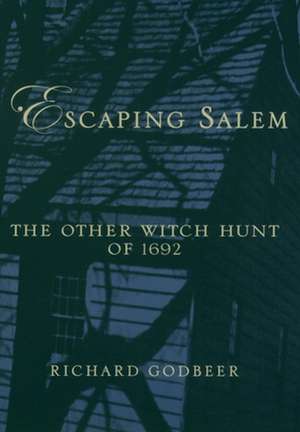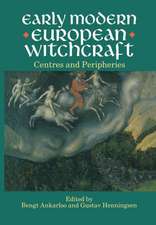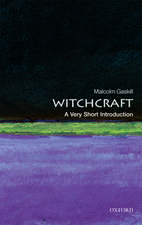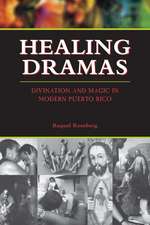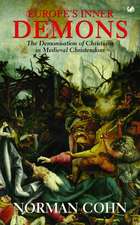Escaping Salem: The Other Witch Hunt of 1692: New Narratives in American History
Autor Richard Godbeeren Limba Engleză Paperback – 23 feb 2005
Drawing on eyewitness testimony, Richard Godbeer tells the story of Kate Branch, a seventeen-year-old afflicted by strange visions and given to blood-chilling wails of pain and fright. Branch accused several women of bewitching her, two of whom were put on trial for witchcraft. Escaping Salem takes us inside the Connecticut courtroom and into the minds of the surprisingly skeptical Stamford townspeople. Were the pain and screaming due to natural or supernatural causes? Was Branch simply faking the symptoms? And if she was indeed bewitched, why believe her specific accusations, since her information came from demons who might well be lying? For the judges, Godbeer shows, the trial was a legal thicket. All agreed that witches posed a real and serious threat, but proving witchcraft (an invisible crime) in court was another matter. The court in Salem had become mired in controversy over its use of dubious evidence. In an intriguing chapter, Godbeer examines Magistrate Jonathan Selleck's notes on how to determine the guilt of someone accused of witchcraft, providing an illuminating look at what constituted proof of witchcraft at the time. The stakes were high--if found guilty, the two accused women would be hanged.
In the afterword, Godbeer explains how he used the trial evidence to build his narrative, offering an inside perspective on the historian's craft. Featuring maps, photos, and a selected bibliography, Escaping Salem is ideal for use in undergraduate U.S. survey courses. It can also be used for courses in colonial American history, culture, and religion; witchcraft in the early modern world; and crime and society in early America.
Preț: 219.86 lei
Nou
Puncte Express: 330
Preț estimativ în valută:
42.07€ • 44.04$ • 35.02£
42.07€ • 44.04$ • 35.02£
Carte disponibilă
Livrare economică 10-24 martie
Preluare comenzi: 021 569.72.76
Specificații
ISBN-13: 9780195161304
ISBN-10: 0195161300
Pagini: 192
Ilustrații: 4 halftones, 2 maps, 4 line illus.
Dimensiuni: 127 x 203 x 15 mm
Greutate: 0.23 kg
Editura: Oxford University Press
Colecția OUP USA
Seria New Narratives in American History
Locul publicării:New York, United States
ISBN-10: 0195161300
Pagini: 192
Ilustrații: 4 halftones, 2 maps, 4 line illus.
Dimensiuni: 127 x 203 x 15 mm
Greutate: 0.23 kg
Editura: Oxford University Press
Colecția OUP USA
Seria New Narratives in American History
Locul publicării:New York, United States
Descriere
Few events in American history are as well remembered as the Salem Witch Trials of 1692. But there was another witch hunt that year, in Stamford, Connecticut, that has never been examined in depth. Now Richard Godbeer describes this "other witch hunt" in a concise, fascinating narrative that illuminates the colonial world and shatters the stereotype of early New Englanders as quick to accuse and condemn. That stereotype originates with Salem, which was in many waysunlike other outbreaks of witch-hunting in the region. Drawing on eye-witness testimony, Godbeer tells the story of Kate Branch, a seventeen-year-old afflicted by strange visions and given to blood-chilling wails of pain and fright. Branch accused several women of bewitching her, two of whom were put on trial for witchcraft. The book takes us inside the courtroom—and inside the minds of the surprisingly skeptical Stamford townfolk. Was the pain and screaming due to natural causes, or to supernatural causes? Was Branch simply faking thesymptoms? And if she was telling the truth, why believe the demonic sources of the information, who might well be lying? For the judges, Godbeer shows, the trial was a legal thicket. All agreed that witches posed a real and serious threat, but proving witchcraft (an invisible crime) in court was anothermatter. The court in Salem had become mired in controversy over its use of dubious evidence. In an intriguing passage, Godbeer examines Magistrate Jonathan Selleck's notes on how to determine the guilt of someone accused of witchcraft—an illuminating look at what constituted proof of witchcraft at the time. The stakes were high—if found guilty, the two accused women would be hanged. In the afterword, Godbeer explains how he used the trial evidence to build his narrative, an inside look at the historian's craft that enhances this wonderful account of life in colonial New England.
Recenzii
Godbeer's account of this entire process is a gripping narrative...the book succeeds brilliantly...compelling.
This is a lively, accessible and intelligent case study, closely informed by the scholarship of Keith Thomas, David Hall, Mary Beth Norton and John Demos, and building on Godbeer's own major work on the subject, The Devil's Dominion: Magic and Religion in Early New England
This is a lively, accessible and intelligent case study, closely informed by the scholarship of Keith Thomas, David Hall, Mary Beth Norton and John Demos, and building on Godbeer's own major work on the subject, The Devil's Dominion: Magic and Religion in Early New England
